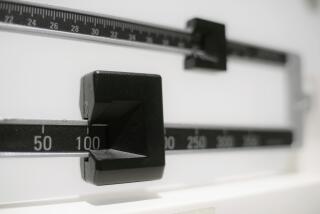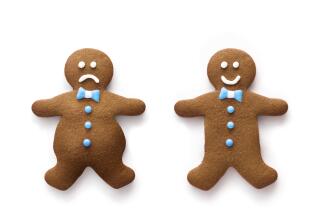How to reduce waist size? Or lose weight after hitting a plateau?
- Share via
Any advice for those who are not overweight but whose waistlines keep growing? At age 68, I weigh the same as in college 50 years ago, but my waist is three to four inches larger. I exercise five times a week and eat a healthful diet.
Frederick Frey
Canoga Park
Growing waistlines are common as people age. You’re right to be concerned with how to reduce abdominal girth, because studies show this fat accumulation is a risk factor for diabetes and heart disease, independent of weight. Some researchers even refer to this condition as “normal-weight obesity.”
Sadly, there is no quick fix for belly fat. Studies show that regular exercise is better than just dieting for getting rid of it -- because you’re already exercising quite a lot, you might try increasing the intensity of your aerobic workouts. Chances are you would lose some weight; studies show the first fat to disappear is often abdominal.
It’s also essential to do exercises to strengthen your core abdominal muscles, according to Marcy Gregory, a dietitian in Rancho Mirage and author of the book “Lose the Belly Fat.” One 2005 study showed modest strength training reduced abdominal fat in women, even though the women’s weight and BMI did not change.
Some small studies have shown that the supplement DHEA can decrease abdominal fat. DHEA is associated with some health risks, however, so you should discuss that approach with your doctor.
Finally, Gregory says, stress contributes to abdominal fat via the release of cortisol, a hormone that facilitates fat storage. “Exercise can do double duty by relieving stress and helping to create muscle tissue that can override the fat storing effect,” she says.
--
Shari Roan
I’m an overweight mail carrier, and I want to lose weight while I work. My body is used to the walking I do. I can’t increase my speed or steps.
Bernadette
Buffalo, N.Y.
Even though you’re undoubtedly walking miles nearly every day, your body has hit a plateau. This often befalls people in active occupations such as waiting tables, nursing and construction. Eventually the body adapts to the activity, becoming more efficient at it, and the pounds stop coming off.
You can lose weight, starting with small changes in your work routine that will break your body out of its rut, says Justin Price, a San Diego-based personal trainer. He suggests walking on grass instead of pavement when possible, because walking on uneven surfaces makes the body work harder. “I know this sounds weird,” he adds, “but you can also walk backward, sideways, even skip. You could carry the mail in different ways. If you’re distributing it just on one side, your body gets used to that.”
Shifting the weight will engage new muscles and also help adjust any imbalances caused by continually bearing the load in one area. Price says these changes should be made gradually so your body can adjust.
He also suggests supplementing the cardio you get on your route with strength training, which can be done at a gym, or at home with light dumbbells or bands, or even using your own body weight. “Right now you’re not building lean muscle tissue, since you’re only doing aerobic work,” he says. “When you increase your lean muscle mass, your body composition will change, and you’ll burn more calories.”
You may be able to get some resistance training on the job, says trainer Patrick Spring at the Sports Club/LA. He recommends doing squats during breaks, as well as using the back of your mail truck to do incline push-ups. You can also try resistance bands for upper and lower body strength training.
If you’ve never done these exercises before, it’s important to use proper form to get the most out of the workout and prevent injury. Videos and books might help, as will signing up for one or two sessions with a certified personal trainer. Trying yoga or Pilates isn’t a bad idea either, Spring says.
If there’s a park on your route, take advantage of it during breaks. “Run some stairs to change things up,” says Studio City-based Robert Reames of Gold’s Gym Fitness Institute, author of “Make Over Your Metabolism.” Running stairs, doing sprints, walking quickly uphill: all are forms of cardio interval training, which raises your heart rate and helps burn calories. Start slowly: a minute at a high intensity, bring it down for a few minutes, then go back up for a minute. Don’t push beyond your limits.
All the trainers recommended examining your diet, then tweaking it. Keep a food diary for at least a week to see where improvements can be made. Eat breakfast and include whole grain carbohydrates to give you fuel for your route. Choose healthful snacks: fruit, small amounts of nuts or peanut butter, raw vegetables. For help, consult a registered dietitian or someone with a solid nutrition background.
--Jeannine Stein
For the answer to a reader’s question on hypnosis, go to latimes.com/hypno. E-mail your health-related questions to [email protected].






